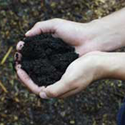
by Roy Carter | Mar 25, 2014

Image Credit UF IFAS Gardening solutions.
What does it mean to grow gardens organically? It depends upon who you talk to. The simple answer is that organic gardeners only use animal or plant-based fertilizers rather than synthetic. It also means use of natural pest control devoid of synthetically manufactured insecticides. In other words, using natural substances and beneficial insects to ward off pests instead of spraying with the backyard equivalent of Malathion. My information on organic vegetable gardening was provided by UF IFAS Extension Publication “Organic Vegetable Gardening” HS 1215.
Why garden organically? Since “USDA Certified Organic” does not apply to home gardening, why would any gardener give up all synthetic fertilizers? And why not use synthetic pesticides, when just one application could eliminate even the most devastating ravages of a crop insect or disease? Why work, so hard handling large quantities or organic soil amendments and manures when synthetic fertilizer of every description and purpose are so quickly available and easy to use?
Early organic gardeners did it to preserve a way of life that reduced pollution and environment decay, thus creating a more ecological society. Organic enthusiasts are extremely health-conscious, and hope that working vigorously outdoors and eating foods free from pesticides just might lead to better nutrition and health.
The biggest differences between organic and conventional gardening are in the area of fertilization and pest control. The organic gardener prefers organic materials and natural methods of dealing with insect problems and fertilizer requirements. The conventional gardener uses a combination of chemically prepared materials and scientific methods in approaching the vegetable garden.
Whichever method you choose, you need to select a plot of good, well-drained soil for planting vegetables. Also, it is important to choose vegetable varieties suited to Florida growing conditions.
Soil preparation is the most important step in organic gardening. Since organic fertilizers and soil conditioning materials work rather slowly, they need to be mixed into the soil at least three weeks ahead of planting time.
To have a successful organic garden, you need to use abundant quantities of organic material, usually in the form of animal manures, cover crops, compost or mixed organic fertilizer. These materials improve the tilth, condition, and structure of the soil. They help the soil hold water and nutrients better. In addition, organic matter supports micro-biological activity in the soil, and contributes major and minor plant nutrients. Another benefit is that as these organic matters decompose, they release acid which help to convert insoluble natural additives, such as ground rock, into forms plants can use.
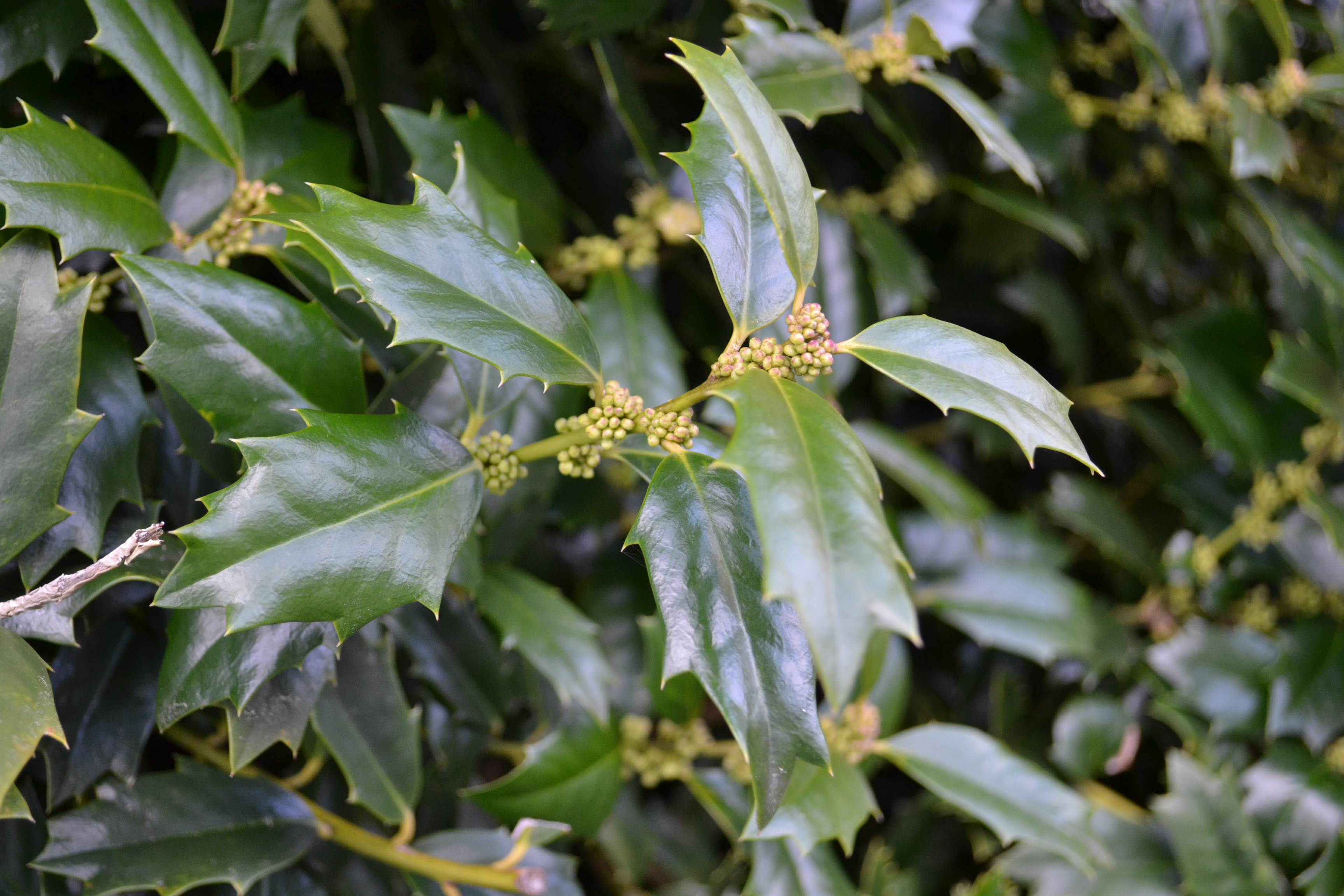
by Beth Bolles | Mar 12, 2014
Landscapes will soon be transitioning from the dormant phase to actively growing and one of the most beneficial insects of all will be back in action. As soon as flowers open, bees will be visiting to gather pollen and nectar.
This year be a little more observant in the landscape and at your local nursery so that you protect bees during your yard activities. Several insecticides will have new labels that indicate a toxicity to bees and restrictions about applications to blooming plants. Since many landscapes have a wide variety of blooming plants, be very careful not to inadvertently spray when bees are visiting open flowers. Bees are not only killed by a direct spray of certain insecticides, but may carry residual pesticides back to the colony in pollen and nectar.
Since bees and other pollinators are so vital to our food production system, all people who work in landscapes or enjoy gardening as a hobby, need to be a part of bee protection. Read labels, only spray when absolutely necessary, and learn that a little cosmetic damage is worth it in order to protect pollinators.
Some selections of hollies are one of the first landscape shrubs visited by bees in the winter. Learn about the other plants in your yard that are visited by bees so you are better able to protect them.
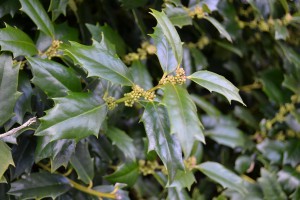
Holly flowers will soon open.
Photo: Beth Bolles, UF IFAS Escambia County Extension
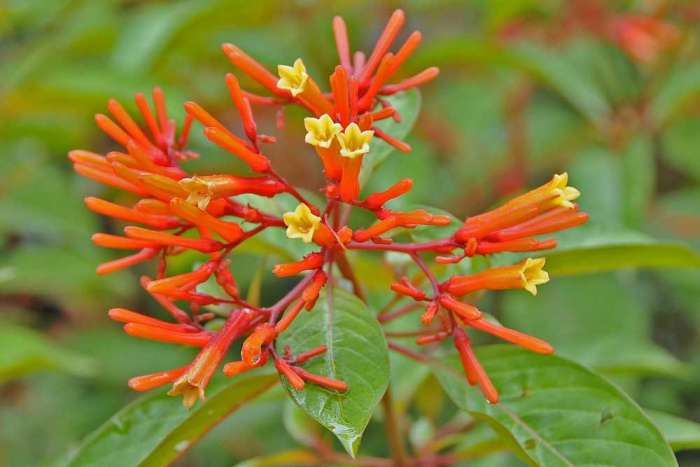
by Taylor Vandiver | Feb 25, 2014
So you have alkaline soil… What next?
Throughout the Panhandle, a common problem that often arises is finding a way to raise soil pH. This is due to the fact that we often encounter sandy, acid soils in this region. An often overlooked issue is explaining the process of gardening in a soil that tends to be more alkaline in nature.
Soil pH is measured using a scale from 0 to 14. On this scale, a value of 7 is neutral, pH values less than 7 are acidic, and pH values greater than 7 are alkaline. Soil pH directly affects the growth and quality of many landscape plants. Extreme pH levels can prevent certain nutrients from being available to plants. Therefore, a high pH may make it difficult to grow certain plants.
Often alkaline soils occur in the home landscape as a result of calcium carbonate-rich building materials (i.e., concrete, stucco, etc.) that may have been left in the soil following construction. Soils that contain limestone, marl or seashells are also usually alkaline in nature. There are a few measures that can be taken in order to combat high pH. Incorporating soil amendments containing organic material is the most common method implemented to reverse alkalinity. Peat or sphagnum peat moss is generally acidic and will lower pH better than other organic materials. Adding elemental sulfur is another common practice. A soil test will need to be performed often in order to add the correct amount of sulfur to reach an optimal pH level.
Lowering the pH of strongly alkaline soils is much more difficult than raising it. Unfortunately, there is no way to permanently lower the pH of soils severely impacted by alkaline construction materials. In these circumstances, it may be best to select plants that are tolerant of high pH conditions to avoid chronic plant nutrition problems.
Some plants that will tolerate alkaline soils:
-
Shrubs
- Glossy Abelia (Abelia Xgrandiflora)
- Sweet Shrub (Calycanthus floridus)
- Flowering Quince (Chaenomeles speciosa)
- Burford Holly (Ilex cornuta ‘Burfordii’)
- Indian Hawthorne (Rhaphiolepis indica)
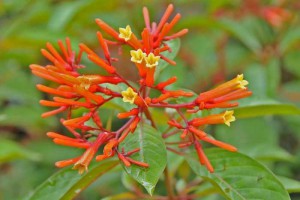
Firebush is wonderful butterfly attractant. Photo courtesy of UF/IFAS.
-
Perennials
- Larkspur (Delphinium carolinianum)
- Pinks (Dianthus spp.)
- Firebush (Hamelia patens)
- Plumbago (Plumbago ariculata)
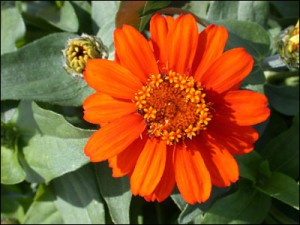
Zinnias come in a variety of colors, shapes and sizes. Photo courtesy of UF/IFAS.
-
Annuals
- California Poppy (Eschscholzia californica)
- Zinnias (Zinnia spp.)
- Cosmos (Cosmos bipinnatus)
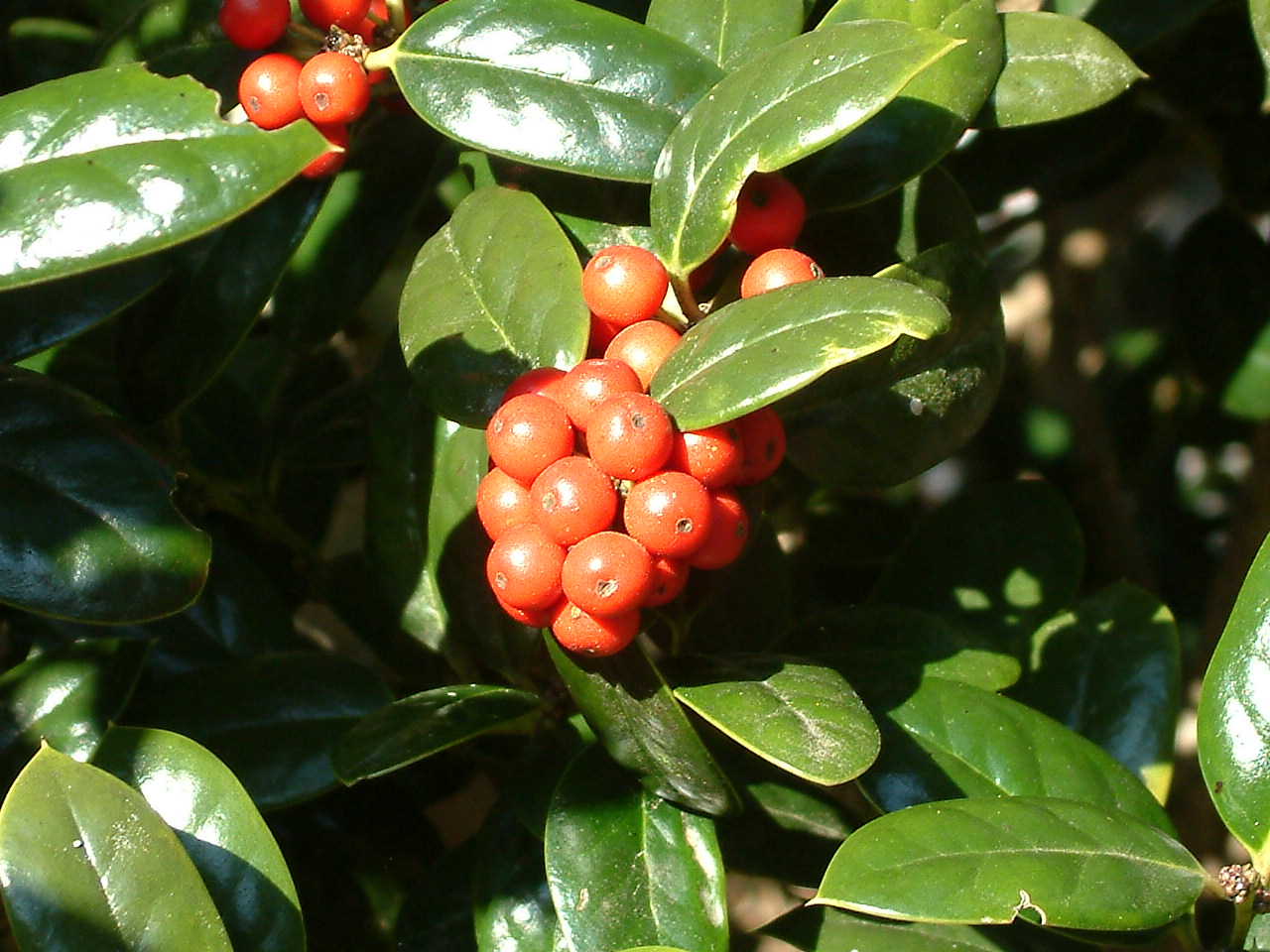
by Beth Bolles | Feb 18, 2014
Looking for a new shrub or small tree this year? Interested in one that is low maintenance and offers beautiful green color? Why not try a holly.
Hollies can be found in landscapes throughout North Florida. Many times these plants are used in foundation plantings around homes. They can help make the transition from the hard lines of a home to other parts of the yard. In other landscapes, hollies make an excellent screen, dividing property or blocking a view.
Because hollies are commonplace, they may be overlooked by homeowners who want to add an attractive new plant to the landscape. Hollies have many uses and there are new selections entering the market worth considering.
In general hollies will not need a great amount of maintenance. Once established most species will require only occasional water, fertilizer, and pruning. Many hollies have even grown well under neglected conditions. If you are one that keeps holly plants pruned as hedges, you will need to watch for the scale insect and spray plants with a horticultural oil every year.
When selecting a holly plant, it is good to know a little about the area where you want to place the plant. Hollies vary in size and ability to tolerate wet soil, so it is important to match a species with your specific site. Also consider holly leaf shapes when using the plants in areas where people walk. Some holly leaves are very stiff and sharp and could injury visitors to you home or be a nuisance when you are working in the yard.
If you are interested in the added beauty of holly berries during the year, remember to select a female plant.
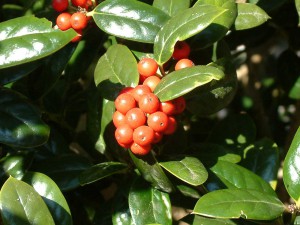
Hollies also attract bees to the landscape.
Credit: Beth Bolles, UF IFAS Extension Escambia County
Tree form hollies that you may select include the American holly (Ilex opaca), Savannah holly (Ilex x attenuata ‘Savannah’), and the Burford holly (Ilex cornuta ‘Burfordii’). All three plants will need well-drained soil. The American and Savannah holly will both reach heights between 20 and 40 feet and have a pyramidal growth form. The Savannah holly leaves will be a lighter green color than the leaves of other holly species. Burford holly has thick dark green leaves and grows about 12-15 feet in height over time.
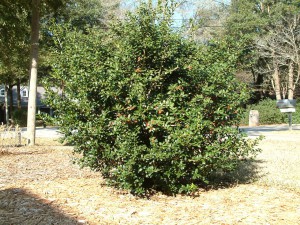
Burford holly is a beautiful holly that gives birds a place to hide.
Credit: Beth Bolles, UF IFAS Extension Escambia County
If you have a wet site, consider the Dahoon holly which can be a specimen plant or used as a screen. This plant will develop attractive grayish bark and grow about 20 feet in height with more of a spread than the previously mentioned hollies.
There are medium-sized hollies that make excellent specimen plants about 12 feet in height. ‘Festive’ holly has dark green foliage and forms dense growth in a pyramidal form. The ‘Robin’ holly has a similar growth form but displays beautiful reddish new growth. Both of these plants will need well-drained soil and full sun or partial shade.
For those areas that require smaller evergreen plants, consider a ‘Bordeaux’ yaupon holly. These plants will grow about 4 feet in height and spread and form a dense growth of stiff stems with small leathery leaves. Since these plants keep a naturally round form it is not necessary to shear them. Both hollies will tolerate a wide range of soil conditions and require little maintenance once established.

by Carrie Stevenson | Jan 14, 2014
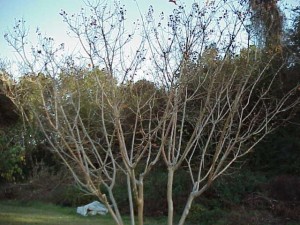
The branching structure of crape myrtles makes an impact to landscapes even in winter time. Photo credit: Beth Bolles
Most people associate yard work with the spring and summer, but if you’re considering a major redesign of a home landscape, now is a great time to start. Without the vegetation on deciduous trees, it’s easy to see the “bones” of your yard—the tree trunks and branches, sidewalks, and fences—which frame it.
One of the best ways to start with landscape design is a piece of paper and pencil. If you’ve got a paper copy of your survey, even better—you can sketch in trees, sidewalks, and fences with an aerial view and see where the open spots lie. Take some time to walk around your yard, considering how you use the space. Do you have children or pets that need room to run? A shady area for relaxing? Full sun for a garden? All of these uses can co-exist in a single yard, but the key to good landscape design is allowing for them to flow together in a logical, attractive way.
If you’ve never put together a comprehensive landscape design before, there are several very helpful tools online provided by horticulture experts with UF IFAS Extension. The “pattern guide” is ideal for starting and completing small projects, such as side yards, shade areas, etc. and even suggests appropriate plants based on light conditions and region of the state. Using this guide is a great way to start from scratch and build up to a diverse, healthy landscape. On the other hand, if you are essentially satisfied with your yard but just need a few accent plants or another tree somewhere, a great online resource is http://deactivated_site/. Here, you can enter a set of specific criteria based on the type of plants you’re looking for, and the site will create a customized list of suggestions to use in your landscape.

The online Florida-friendly landscaping pattern book has great ideas for redesigning your landscape.
After deciding on additional needs for hardscape and plantings, the next step is to make room for them by removing sod or unwanted landscape plants. Now is also the time to look at irrigation needs—if you have an existing system, make sure it still works with your new landscape design. If it doesn’t, it’s much better to redirect water, piping, or add new sprinkler heads while you’re digging into the soil than after you’ve finished installing new vegetation. If you aren’t using an irrigation contractor, you’ll need a solid understanding of how the system is set up before making changes. Inexpensive kits can also be purchased to add drip or micro-irrigation to an already-installed system.
Once irrigation and hardscape are complete, you can begin with plant installation. It makes the most sense to plant trees first, add mulch around the root zone, then put in shrubs and groundcovers based on your plan. Many do-it-yourselfers will take their time on this step, adding new plants as time and budget allow. This method works well and can be a fascinating way to watch your yard transform.
We have many great resources for more in-depth discussion of landscape design and irrigation work, including your local UF IFAS Extension office. Don’t hesitate to call us with questions or send photos of your new and improved yards!
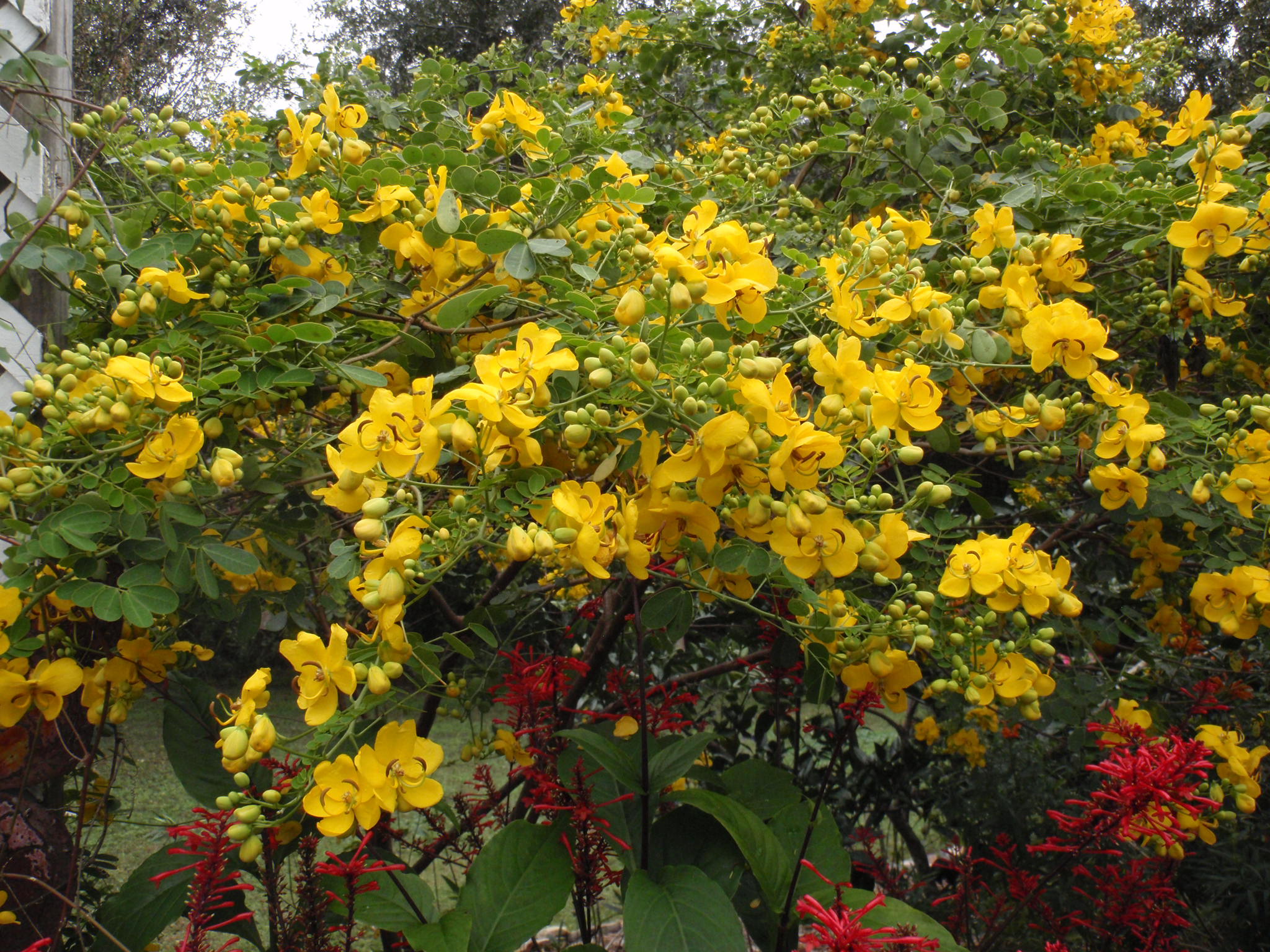
by Beth Bolles | Jan 14, 2014
Trees and shrubs often serve a distinct purpose in landscapes, other than to provide color. They are planted to provide shade, screen a view or noise, or to soften the hardscapes of the home.
With a little planning, we can have both beauty and function from trees and shrubs. Add a few trees and shrubs that have color in different seasons and your landscape will always be interesting.
The added benefit of growing trees and shrubs is that they are low maintenance. Once the plants are established in the landscape, they will require very little water and only an occasional application of a slow release fertilizer. A good layer of an organic mulch around the plants will help conserve moisture, prevent weeds, and keep root temperatures regulated during our temperature extremes. You may have to do a little pruning every year to remove any diseased, damaged, or severely crossing branches.
Here is a list of plants to give you garden interest throughout all seasons:
Winter color
- Taiwan cherry (Prunus campanulata) is an underutilized ornamental cherry for the coastal south. Clusters of dark pink flowers cover the plant which grows about 20 feet.
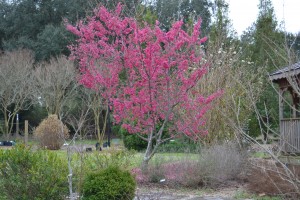
Taiwan cherry
- Camellia japonica is widely used in landscapes, but still an excellent choice for winter color. Careful selection of types will provide a garden with color from November through April.
- Red maple (Acer rubrum) will provide color in both the late winter and fall. Flowers are brilliant red in late winter and leaves begin turning red in late October.
- Other choices include Oakleaf hydrangea, Florida anise, Red buckeye, and Japanese magnolia
Spring
- Fringe tree (Chionanthus virginicus) can be in shrub or tree form and range in height from 10 – 20 feet. Forms white clusters of showy fringe-like flowers in late winter and early spring before the leaves emerge.
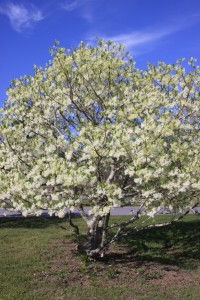
Fringe tree
- Chinese fringe (Lorepetalum chinesis ‘Rubrum’) is a very popular shrub. Pink blooms are heaviest in the spring. The plants can get up to 12 feet in height so plant it were it will not obstruct a view.
- Virginia sweetspire (Itea virginica) forms clusters of white flowers. Plants offer purplish foliage in the fall.
- Other choices include Banana shrub, native azaleas, Indian hawthorn, and Deutizia,
Summer
- Chaste tree (Vitex agnus castus) is a large shrub with fragrant leaves and spikes of purple flowers. Tolerates drought and develops interesting shape.
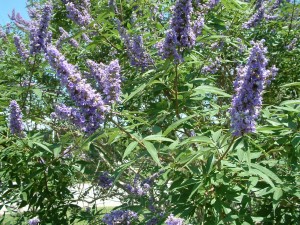
Chaste tree
- Loblolly bay (Gordonia lasianthus) is an evergreen tree that grows to 25-35 ft in height. Large white flowers with yellow stamens resemble camellia blooms.
- Abelia spp has white flowers that appear over the entire plant. It is attractive to butterflies .
- Other choices include Crape myrtle, Althea, Confederate rose, and Oleander
Fall
- Bald cypress (Taxodium distichum) will become a large tree over time. In the fall the feathery leaves will turn orange-brown. Good tree for both wet and dry areas.
- Beautyberry (Callicarpa americana) a native that forms clusters of purple berries that line the stem. Leaves turn yellow and provide fall interest as well.
- Cassia bicapsularis can reach 8-12 ft in height and will have bright yellow flowers that form in October and persist until a freeze.
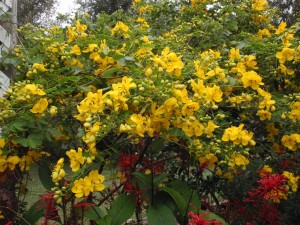
Cassia

















